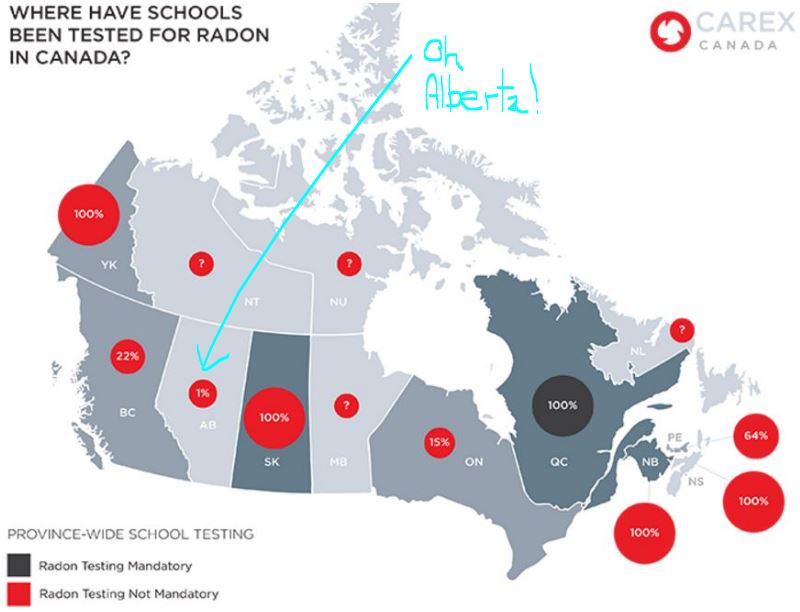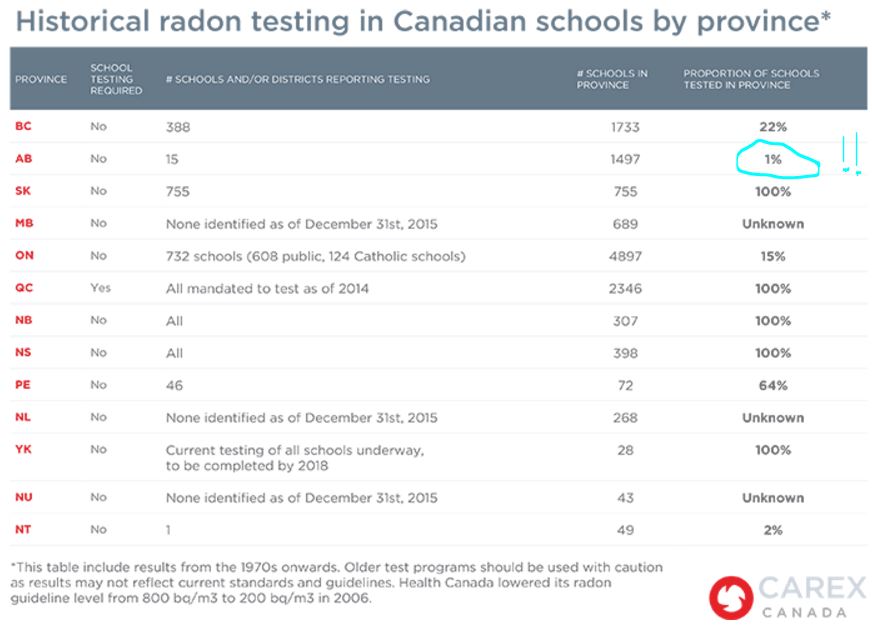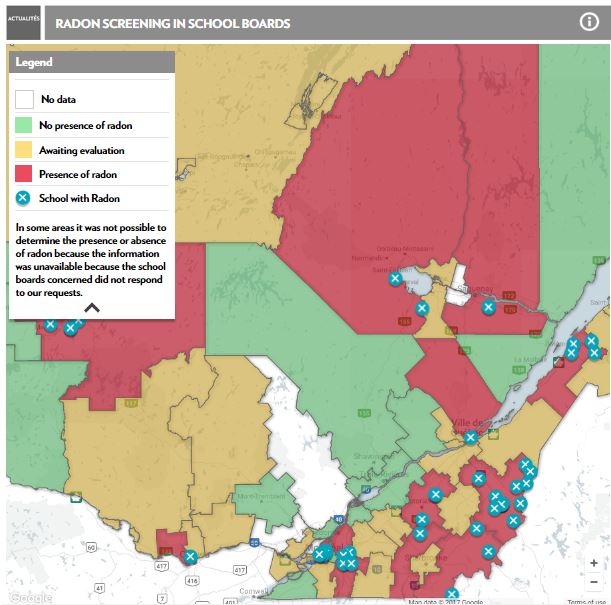Comment to posting of this post on Alberta Surface Rights Group Facebook Page:
Rob Schwartz Perhaps Alberta’s lack of testing for radon might have a lot to do with the venting , flaring , land spreading , and oilfield solids disposal and flowback fluids handling expectations as required by the AER. I find it more than interesting that the AER regulates the conduct of the producers of a significant % of airborne. waterborne and soilborne pollutants with known health effects yet have no mandate to regulate health impacts. At first glance one might conclude that the prospect of “dropping the ball” may have been purposely designed into the regulatory system.
Radon in schools: A summary of testing efforts across Canada by CAREX Canada, Surveillance of Environmental and Occupational Exposures for Cancer Prevention, October 24, 2016
Radon gas is the leading cause of lung cancer among non-smokers and is responsible for approximately 16% of lung cancer deaths in Canada, which translates to more than 3,200 lung cancer deaths per year.1,2 As radon is colourless and odourless, testing is the only way to know if radon levels are elevated and remediation is required. Many organizations are working to assess radon exposure in homes and raise awareness about the importance of home testing. Given that children and staff spend a considerable amount of time indoors in schools – where radon levels can also build up – the CAREX Canada team sought to investigate radon testing in schools across Canada.
CAREX Canada is a national project based at Simon Fraser University that estimates Canadians’ exposures to cancer-causing agents in workplaces and communities.3 Led by Associate Professor Anne-Marie Nicol, CAREX staff contacted Ministries of Education as well as school boards, unions, and radon professionals in an effort to determine where school testing has occurred in Canada and when possible, to obtain school testing results. This research focused on testing and did not collect information on whether mitigation efforts had occurred. Mitigation is key to reducing elevated radon levels.
Key findings from this investigation include:
- Only one province (Quebec) has mandatory school radon testing.
- Three other provinces (Saskatchewan, New Brunswick, and Nova Scotia) and one territory (the Yukon) reported having all schools tested at least once since Health Canada’s guideline changed to 200 Bq/m3 in 2007.
- British Columbia, Alberta, Ontario, and Manitoba have low rates of school testing since 2007.
- In provinces that lack concerted, province-wide testing, some school districts and even schools had undertaken their own testing initiatives.
- While this research focused on the public school system, some independent schools in specific regions were tested for radon.
Why radon exposure matters: CAREX Canada has a carcinogen profile on radon, available here. Radon is a radioactive gas released when uranium, found naturally in rocks and soil, decays. This gas emits radioactive particles that can attach to the surface of aerosols, dust, and smoke and are easily inhaled into the lungs, causing damage to DNA that can develop into cancer.4 [Alberta’s air is mightily polluted with dust, smoke from wildfires often raging out of control and oil field pollution, especially from tarsands, flaring & fracing] CAREX Canada risk estimates for indoor air carcinogens show that radon gas is the highest priority exposure in Canadian settings.5 The gas can enter and accumulate in buildings through unfinished floors, wall slab joints, sump pumps, windows, and cracks and openings in foundations.6 The US EPA estimates that one in five schools in the US have elevated radon levels.7
What is being done about this exposure: As part of their Cross-Canada Survey of Radon Concentrations in Homes, Health Canada has tested many dwellings across the country. The results of this survey are visualized in maps available on the CAREX Canada website.8,9 These maps illustrate how some provinces have higher overall levels than others. In order to minimize health risks, Health Canada recommends that all buildings, including homes and schools, be tested and remediated to ensure they have less than 200 Bq/m3 of radon gas.10 Health Canada also recently released an updated guide to school testing.11
We developed a fact sheet with the BC Teachers’ Federation outlining how exposure is taking place, what past test results show, and what other provinces are doing about this issue. This fact sheet is available here.
For a full list of CAREX resources on radon exposure in workplaces and communities, please visit our Radon Resources page.
References
- Health Canada. What are the health effects of radon? (Last updated September 2012)
- Chen J, Moir D, Whyte J. Canadian population risk of radon induced lung cancer: a re-assessment based on the recent cross-Canada radon survey. Radiat Prot Dosimetry 2012;152(1-3): 9-13.
- CAREX Canada. What is CAREX? (2016)
- ATSDR. Toxicological Profile for Radon. (Last updated January 2015)
- CAREX Canada. Radon: Environmental estimate – Indoor air. (2013)
- Health Canada. Radon: Is it in your home? (2014)
- US Environmental Protection Agency. Radon in Schools. (Last updated September 2016)
- Health Canada. Cross-Canada Survey of Radon Concentrations in Homes – Final Report. (2012)
- CAREX Canada. Radon: Provincial Tables and Maps. (2011)
- Health Canada. How to test for radon? (2014)
- Health Canada. Guide for Radon Measurements in Public Buildings. (2016)
Map of radon in Quebec schools by LaPress.ca, November 20, 2013
Nearly 50 primary and secondary schools in Quebec record radon concentrations that exceed the acceptable threshold set by Health Canada, reveals a preliminary compilation carried out by La Presse on the basis of data obtained from the Quebec school boards by law of Access to Information. To date, concentrations in excess of the guideline of 200 becquerels per cubic meter (Bq/m3) have been detected in 19 school boards. The screening and testing process is ongoing in 22 others while 19 other school boards do not have sufficient radon levels to be reported. [Emphasis added]
[Refer also to:




